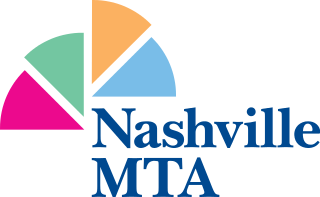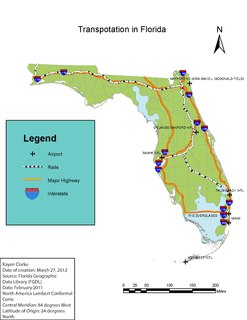
Trinity Metro is a transit agency located in and serving the city of Fort Worth, Texas and its suburbs in surrounding Tarrant County, part of the Dallas–Fort Worth metropolitan area. Since 1983, it was previously known officially as the Fort Worth Transportation Authority (FWTA), and branded itself as The T. As of January 29, 2018 the Board of Directors has voted to rebrand bus services as Trinity Metro, replacing the previous and long standing name. In 2021, the system had a ridership of 3,837,100, or about 12,000 per weekday as of the first quarter of 2022.

The Niagara Frontier Transportation Authority (NFTA) is a New York State public-benefit corporation responsible for the public transportation oversight of Erie and Niagara counties. The NFTA, as an authority, oversees a number of subsidiaries, including the NFTA Metro bus and rail system, the Buffalo-Niagara International Airport, the Niagara Falls International Airport and NFTA Small Boat Harbor. The NFTA Metro bus and rail system is a multi-modal agency, utilizing various vehicle modes, using the brand names: NFTA Metro Bus, NFTA Metro Rail, NFTA Metrolink and NFTA PAL. In 2021, the system had a ridership of 12,503,900, or about 44,400 per weekday as of the first quarter of 2022.

Lynx is a bus system run by the Central Florida Regional Transportation Authority, serving the greater Orlando, Florida area in Orange, Seminole, and Osceola counties with limited service to Polk County. Bus routes are referred to as Links. In 2021, the system had a ridership of 14,317,600, or about 33,100 per weekday as of the first quarter of 2022.

Transportation in Philadelphia involves the various modes of transport within the city and its required infrastructure. In addition to facilitating intracity travel, Philadelphia's transportation system connects Philadelphia to towns of its metropolitan area and surrounding areas within the Northeast megalopolis.

A tourist trolley, also called a road trolley, is a rubber-tired bus designed to resemble an old-style streetcar or tram, usually with false clerestory roof. The vehicles are usually fueled by diesel, or sometimes compressed natural gas.
Oklahoma City is near the geographic center of the United States and is an integral point on the U.S. Interstate Network. The city is served by numerous roads and highways, toll roads, three major airports, a train station, a bus station, and a transit system.
This article is about transportation systems in and around Dallas, Texas (USA).
As with most American cities, transportation in Louisville, Kentucky is based primarily on automobiles. However, the city traces its foundation to the era where the river was the primary means of transportation, and railroads have been an important part of local industry for over a century. In more recent times Louisville has become a national hub for air cargo, creating over 20,000 local jobs. The city has also launched several initiatives to promote both utilitarian and recreational bicycling. In 2016 Walk Score ranked Louisville 43rd "most walkable" of 141 U.S. cities with a population greater than 200,000. In 2015, 11.7 percent of Louisville households were without a car, which decreased to 10.9 percent in 2016. The national average was 8.7 percent in 2016. Louisville averaged 1.61 cars per household in 2016, compared to a national average of 1.8 per household.

Shreveport is the third largest city and the principal city of the third largest metropolitan area in the U.S. state of Louisiana, as well as being the 109th largest city in the United States.

Streetcars or trolley(car)s were once the chief mode of public transit in hundreds of North American cities and towns. Most of the original urban streetcar systems were either dismantled in the mid-20th century or converted to other modes of operation, such as light rail. Today, only Toronto still operates a streetcar network essentially unchanged in layout and mode of operation.

WeGo Public Transit is a public transportation agency based in Nashville, Tennessee. Consisting of city buses and paratransit, the system serves Nashville and Davidson County. Most bus routes serve the downtown transit station, Music City Central. This makes MTA the largest transit agency where most of the bus routes terminate in a Central Business District with no crosstown service. The crosstown services that do not terminate in downtown Nashville are the Wedgewood, the Midtown, the Grassmere/Edmondson Connector, the Bell Road, the Madison Connector, and the Thompson Lane Connector. In 2021, the system had a ridership of 4,988,000, or about 20,100 per weekday as of the first quarter of 2022.

Transportation in Florida includes a variety of options, including Interstate Highways, U.S. Highways, and Florida State Roads; Amtrak and commuter rail services; airports, public transportation, and sea ports, in a number of the state's counties and regions.

Chicago, Illinois is the third-largest city in the United States and a major transportation hub for the Midwest. The city is served by two major airports, and is the main freight rail hub of North America.
This article is intended to give an overview of transportation in North Carolina.

The Greater Miami area, composed of the three counties of Miami-Dade, Broward, and Palm Beach, also known collectively as South Florida, is home to a wide variety of public and private transportation systems. These include heavy rail mass transit (Metrorail), commuter rail (Tri-Rail), automated guideway transit (Metromover), highways, two major airports and seaports, as well as three county-wide bus networks, which cover the entire urbanized area of South Florida. Census and ridership data show that Miami has the highest public transportation usage of any city in Florida, as about 17% of Miamians use public transportation on a regular basis, compared to about 4% of commuters in the South Florida metropolitan area. The majority of public transportation in Miami is operated by Miami-Dade Transit (MDT), which is currently the largest transit system in Florida and was the 14th largest transit system in the United States in 2011.
Atlanta's transportation system is a complex infrastructure of several systems, including 47.6 miles of heavy rail, 91 bus transit routes, 1,600 licensed taxis, a comprehensive network of freeways, the world's busiest airport and over 45 miles of bike paths.
Prior to 1959, Montreal, Quebec, Canada had an extensive streetcar system. The streetcar network had its beginnings with the horsecar era of the Montreal City Passenger Railway in 1861. The initial line was along Rue Notre Dame from Rue du Havre to Rue McGill.
Streetcars were the primary mode of public transport in Tacoma, Washington, United States from the late 1800s until their discontinuance in 1938. Operated together with a network of interurbans, streetcars provided transport within Tacoma and throughout the Puget Sound region. Buses replaced the last streetcars in 1938. Streetcar-type transportation returned to Tacoma in 2003 with the opening of the Tacoma Link, a 1.6-mile (2.6 km) light rail line in Downtown Tacoma. There are proposals both to expand this system and to construct a new heritage streetcar system.










